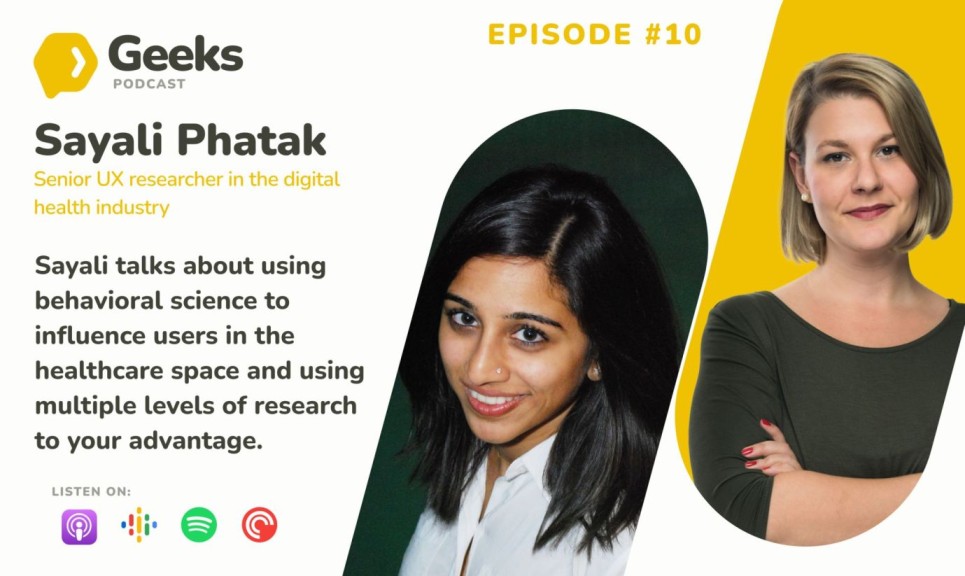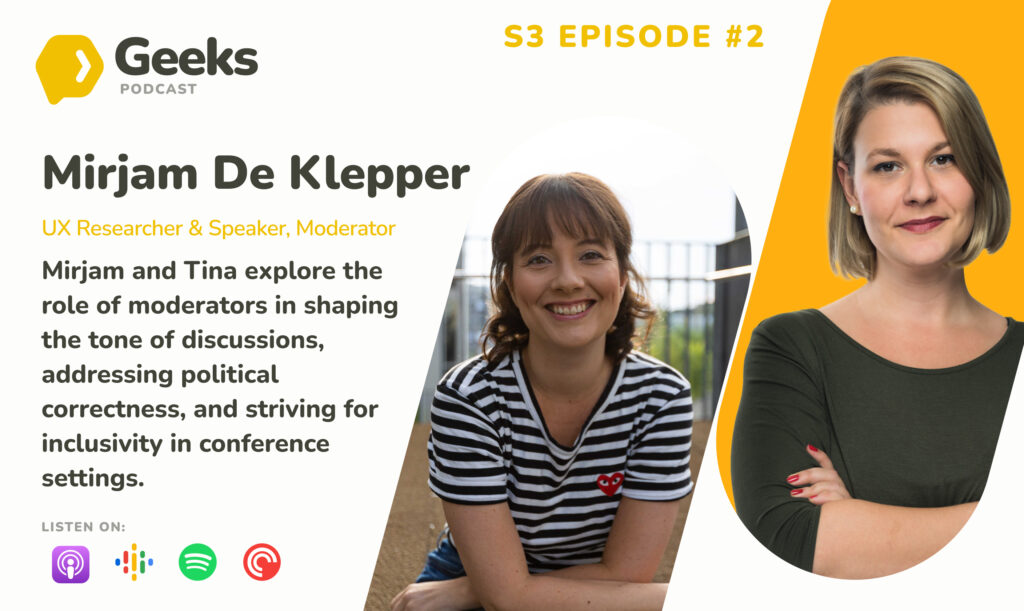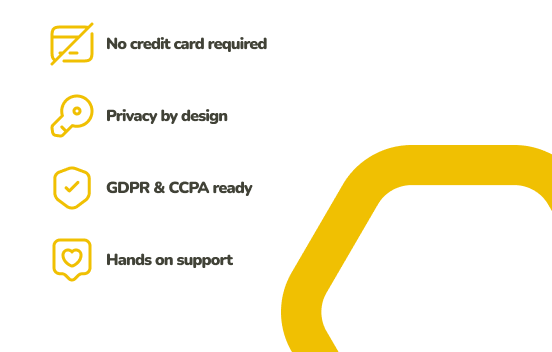Episode highlights
- 00:03:30 – Why asking “why” in user research can be problematic
- 00:05:43 – The psychology behind people’s inability to explain why truthfully
- 00:12:28 – Using storytelling as a more effective method for gathering insights
- 00:17:18 – The dangers of rationalization in interviews and how to avoid it
- 00:29:59 – Why asking “why” in surveys can be more acceptable
- 00:32:03 – Where to follow Glenn for more insights
About our guest
Glenn, a research strategist based in Belgium, helps organisations advance their research practice and de-risk their decisions by gaining evidence about what their customers need and want. He mixes qualitative and quantitative methods to observe what people need, ask them about it or measure it. Driven to enhance the effectiveness and validity of insights, he’s passionate about optimising research design and finetuning questions and tasks.
Over nearly a decade as a UX contractor, he’s partnered with clients like Ahold Delhaize, Novartis, Accountable, Belfius, Auth0 and Red Cross. Currently, he helps ING expand their research methodologies, influence and reach.
Podcast transcript
[00:00:00] Tina Ličková:
Welcome to UX Research Geeks, where we geek out with researchers from all around the world on topics they are passionate about. I’m your host Tina Ličková, a researcher and a strategist, and this podcast is brought to you by UXtweak, an all-in-one UX research tool.
Our guest is Glenn, a UX research consultant who doesn’t just conduct research, but is helping companies move beyond classical customer centric to actually knowing their customers. Our debate is one of the essential ones in our business as we’re looking into asking why and why it can be a terrible idea in research.
What does psychology tell us about people’s ability to explain why, truthfully, why it can be a trap? How may storytelling help us in gathering more accurate user insights? And when is it actually okay to ask why in UX research the next 35? Minutes are an intellectually fulfilling debate coming mainly from Glen’s fascinating knowledge about the topic as a true geek tune in.
We met at UX Insight Conference last April, so I feel like I know you and you had a great presentation on the topic. We are going to talk about who you are and what is important to know about you.
[00:01:35] Glenn Stevens: So I’ve been working as a consultant in digital UX for about 10 years now, and throughout that decade I’ve had the opportunity to work with a wide range of clients across retail, fma, online security tech, accounting tech, and NGO.
And, but to be honest, most of all, I think about 70% is in finance, banking, and insurance. I’m based in Belgium, but my work has led me often remotely, sometimes physically across the globe. My main work, I consult in UX research, but the scope of that I interpret very broadly, I think mm-hmm.
Uh, research is, it’s a much more broader sector than it’s often practiced today. And I perform research, but what I also do for my clients, I help them with the ops, with the culture, lay out the conditions needed to do research, to value research, to do it themselves. So I do a lot of teaching and coaching.
And my kind of mental frame for all of this is almost every organization, they all say that they are customer centric, right? And, and we all wanted to, we all wanna be that. We all feel that. But if we are not doing research, then that is at best lip service. Like how can we be centric towards someone or something that we don’t really know?
So that requires research. The moment the company says yes, we get about our clients, we are customer centric. If you’re doing research, that might be true, if not. I doubt it. And I try to help organizations become truly customer centric by getting them to know their customers better, by doing the research myself or, and or by teaching them to do the research internally and setting up.
[00:03:16] Tina Ličková: And we are going to talk about why not to ask why. I’m also wondering what is the backstory of how you came to, oh, I wanna present on this topic. I need to share my insights on this one.
[00:03:30] Glenn Stevens: As a bit of a teaser about why not to ask, why, it’s not about psychology, but my, what got me into it is more about the interviewing five, the whole conversational dynamic.
There is quite a lot of popular advice out there about always ask why always get down to the bottom of things, even apply the five y technique, which you have participants as if there’s some object to probe. And it never felt well. And, and I think that many people with a lot of experience in moderating.
They must search for their tone of voice. They really try to not come across as interrogatory or repetitive, but for a lot of junior researchers of people who do research but don’t do it constantly, like product managers who do sessions, they don’t master these things. And if you tell those, people always ask why I’ve seen that gone bad?
Something very interrogatory where, where people are just questioned, everything they say is, can you explain yourself to me? And I never liked that. And I made it a habit even before I really started getting into the, the theory behind it to just not do it. Just not ask why and, and get to the why without asking that question.
Try to go at it more indirectly. And one of the metaphors I love most that that fit here as well. It comes from this, it’s quoted by David Travis in one of his books, but he’s quoting another guy, I think Robert Fitzpatrick from the mom test, if I recall correctly. And it’s about, so then excavating fossils.
So imagine dinosaur bones are, and so you have a shovel right to, because you need to dig at some point. It’s often underground, unfortunately. And with SV Blow, you get closer to the fossil, but you also risk smashing it to a million bits and pieces. And I see an interview session or a usability test session as something quite similar.
If we go at it way too bluntly or too directly or too shortly, we risk just smashing the truth to pieces. We need to go at it indirectly, subtly, take our time, take it slow, and the truth will emerge from that.
[00:05:28] Tina Ličková: But let’s go to the psychology because this is something that I would like to geek with you about, you said just right now, okay, we have to be subtle and go there all very.
Patiently, but now I’m going to ask why do we have to do it?
[00:05:43] Glenn Stevens: Because we don’t know why, and we, we, I mean people, our participants, but also ourselves, we are not impervious to this. We are just as susceptible as everyone else. We don’t know why, but that is not stopping us from explaining why. When asked people like to give a response, we’ve been trained to give a response.
It’s more polite. Especially when you invite participants, they, they feel like they, they’re there and they, they need to provide you with stuff. And this is something we need to know about ourselves, but also our participants in the context of research. We need to understand that when we ask why, it comes with a big assumption.
A couple of them, in fact, assumption, one, that people know why, and then assumption too that if they don’t. That they will tell us, I don’t know, but let’s be honest, how often have we heard that from a participant? I, I don’t know why I did what I just did. Mm-hmm. So people rarely respond in such a way, and as I mentioned earlier, we have this popular advice that, that tries to not just to ask why constantly, but the assumption doesn’t hold.
And after we’ve, long, after we’ve met during the talk that I give about this topic, in fact, O only a couple of months ago, I think I was listening to this podcast. And the, the guest was Dr. Allen Short from UCLA. He’s a psychologist, researcher, and a, and a neuro biologist. Mm-hmm. And so he’s researching which brave parts do what, and I’ve actually made a note of it because I knew this podcast was coming, so I’m just gonna read a bit.
So he said, it used to be thought that the unconscious only comes forth in dreams at night, back in the Freud days. But today, where you ask how much of the things are really conscious and how much are unconscious. I’m looking at that neurobiologically in terms of how much of activity is going on in the right brain.
And the right brain is always processing information at levels beneath our conscious awareness. And when it comes to the basic motivations of why we do what we do, 90 to 95% of that is conscious. And our data shows this is the case. We think our conscious mind is making all of these decisions, but underneath the unconscious is always operating.
I love to hearing him say that because if I would’ve heard that before my talk, that would’ve been a quote on the slides. ’cause it perfectly encapsulates the, the psychology of what I’m talking about. The influence of our unconscious and our behavior and our attitudes is extremely large. And the degree to which we can know that unconscious is very small to complete the non-existence.
However. We believe that we can access that. It’s called a direct access fallacy or more popular, the introspection illusion, which is a glorious term. Coined by Emily Proin, another psychologist who also coins by the way, the, the Bias Blind Spots phenomenon, which is very, where our actions are influenced by biases, but we don’t think they are.
We think they are the result of conscious scrutiny and, and well thought out reasons. Now despite the fact that we don’t have this access, this illusion makes us think that we do. And the introspection itself, that part of things, it’s about accessing our unconscious, but that just doesn’t exist the way we all believe it does.
And I think that’s a very important realization and, and for me, I think the concept of the introspection illusion is something I’m gonna take with me for forever. Because it’s not just relevant as researchers with participants, it’s relevant to ourselves. We cannot access our unconscious. If we could, it wouldn’t be unconscious.
[00:09:20] Tina Ličková: Mm-hmm.
[00:09:21] Glenn Stevens: And the problem is that many, if not most of the reasons, the two reasons that we trigger and stimuli behind what we do and how we feel and what we think, they are unconscious. So they are unknowable. Yet people are unaware of their own unaware. And when a researcher with the best of intention starts probing that unaware and funny things happen, and that is something I feel every researcher, especially researchers in in moderated sessions, like qualitative researchers, need to be very well aware of.
And I also wanna take this opportunity to speak a bit more about some of the psychologists that really inspired me here. So I mentioned Emily Proin and I recommend to everyone in your audience very interesting papers. She published on introspection, illusion, and bias blind spots, but a lot of others also deserve a bit of mention.
The first ones who got into this, they are NSBE and Wilson, so Richard nsbe and Timothy Wilson. In fact, for people seeing it, mm-hmm. I am looking at a book. By Timothy Wilson calls with the fantastic title Strangers to ourselves, and it’s basically a little book that goes through all of his research between the seventies and I think the early nineties, which is about when he wrote it.
If I don’t, uh, if I’m not mistaken, and they really uncovered all of what I’m just discussing that people don’t know their two reasons yet. They’re very happy to tell us their reasons when asked.
[00:10:49] Tina Ličková: Hmm.
[00:10:49] Glenn Stevens: Um, Kahneman needs to be seen in this light as well. Uh, um, and I bet many people in your audience are familiar with system one, right?
Very fast, automatic, unconscious, and very high impact on what we do. That’s the whole point. System two is very much reserved for those unique occasions when we call it in, but most of what we do and how we feel is system one. And it’s unknowable. It happens. It impacts us greatly, and it doesn’t leave any conscious trace.
[00:11:19] Tina Ličková: I also catch myself sometimes running an interview and there is an interesting moment and I just even unconsciously just burst out like, oh, why are you doing it this way? And I have my kind of strategies and small critiques on proving what the person is telling me. How you deal with your unconscious of asking why the nudge to do it, and what would you maybe say how researchers should be dealing with it?
[00:11:53] Glenn Stevens: I think I’ve untrained my why reflex, or at least my, so I constantly have the, the voice that you’ve describing of Yeah, definitely. I, I’m telling myself just not to do it, not to ask why directly and. I do wanna know why. Of course, I, I don’t just wanna describe simple facts. I, I, I want to get to what’s happening here, but the way I’m trying to go there is by using more of a directed storytelling approach.
[00:12:27] Tina Ličková: Mm-hmm.
[00:12:28] Glenn Stevens: I wanna first understand the steps people took their, the, the processes that they took their, their journey, basically. And very often when people are explaining to me their experience from, from their point of view, their lived experience in, in, in the richness of the context that then entails the why is very much part of that story.
And because it’s not explicitly probe that you don’t want those risks that we’ve just mentioned, it becomes part of the rich context. And very often I can start understanding. And, and so my, my defaults are how questions to, to try to understand more about the steps that people took. And when people are in the storytelling mode, which is is one of our goals to, to build a rapport and, and to get to show the interesting to a broad response, then their response isn’t just naked facts.
It’s filled with emotions and what they felt. And, and so you get all of these spontaneous rich bits. And I, I think the validity of that, the trustworthiness is much higher than what you get with, tell me why you did that.
[00:13:36] Tina Ličková: Mm-hmm.
[00:13:37] Glenn Stevens: Because going back to one of those psychologists I mentioned, so the original title of the seventies study by NSBE and Wilson, it was called Telling More Than we can Know.
That was a title, so Awesome. As I mentioned in the beginning, like how often have you heard a participant tell you? I don’t know. We are just trying not to show that honesty. It’s not like lying by the way. It’s, we are actively making up things without the impression that we rely on, and this is a process called rationalization, which is a concept in this context of research I learned about first in, in one of, to Chevron’s books, I think got some great pieces about that and that is something we want to avoid.
Rationalization sounds like a smart thing, has got the word ratio and, and rational. Nothing in there but. So basically the whole process of coming up with really smart sounding reasons. And so whenever I catch myself wanting to know why, I’m like, but don’t get them to rationalize because every question can trigger rationalization, but not more so than why.
Because when we ask why the vape of lacking the direct access to the unconscious, remember the introspection illusion makes them believe that there is something there. The vacuum gets filled. And people use specific things to fill that vacuum. So now, and now we’re going back to Kaman who mentioned a couple of heuristics called.
One of them is availability. So we fill the fake queue when asked why, with explanations that are very available, like salient, very pop of minds, right? Which means typical. Stereotypical general well sounding responses. And, and the other criterion for, for what we come up with when we rationalize is representativeness, how plausible is this?
How much does this make sense? Does it sound logical? And then you add in other stuff that we want to avoid as researchers, like social desirability bias. People wanna come across as smart and, and good travelers and good, good with money, and everyone thinks they’re the best driver and. We wanna come across as well, or things like demand characteristics.
People get a sense of, they think they know why they’re there in that research study and they want to be good people, so they wanna give us what they think we want, right? The answer to the question, why is it best to useful fiction? It’s correct only by coincidence, but it sounds good. And that’s the big problem because in especially with interviews, we have this concept called saturation, right?
Theoretical saturation. So you do interviews and if you hear the same thing again and again, that’s really a good sign. That’s what we’ve been taught. And in fact, we can even, I. Influence our sampling strategy. How many people do you need to interview? It depends on when we hit saturation. If we have clear enough picture, we’ve seen enough, if not, see more that.
That’s the whole drama theory. Everything works like this saturation, but if you’re triggering a rationalization. It means you’re getting a lot of typical good sounding responses that come from what the general population finds good sounding responses. So these things do hit saturation very fast and you feel very confident as a reason, or they’re all saying the same stuff.
Yeah. Because they’re all capturing this from the same cultural norms and, and this gives a very false sense of saturation and this really inflates what we believe. We know the themes that we believe we are seeing, and I think that can be. Useless at best and very often can lead us astray to novel insights.
Just rehashing cliches, because that’s what rational rationalization is. It’s cliches, it’s cultural norms, it’s things that sound good and smart.
[00:17:18] Tina Ličková: What is coming in my mind, I was trained years back on mental models. And we are sometimes so much pushed into like what is in the mental state of people, what they’re thinking, but what, where real research and analyzing synthesis starts.
It’s really like what they actually do and what’s the triggers, emotional triggers behind it. I, I don’t have a conclusion to this. I’m just wondering what it, what our discussion will make for me in the next future. And. How much do you think? And that is very tied also to the social likeability, especially with people who’ve been respondents in research, not just once I, what I am observing, even without asking people why.
They tend to come up with whys and I think it’s also a culture of why, not only in the research world, but you know, we are more into therapy and we are trying to find our unconscious whys. And I see sometimes respondents describing some stuff, but always ex going back to I did it, why I did it. Why? How much do you think is it influenced not just by the culture of Y in way broader and general aspect?
[00:18:39] Glenn Stevens: I love that question. I. I don’t know enough from a, like a research psychology point of view to answer, so I’m just gonna answer for my own intuition. I, I think that as researchers, we need to do our best not to trigger this rationalization. We also need to realize that what you described absolutely happens.
So many people rationalize even without being treated. To themselves. Again, for the psychology nerd, the whole festing theory of cognitive dissonance, which is resolved by post hoc rationalization. We try to make it all in our minds. We just make up things. So people do this even when not pros or asked, and people are often likely to give it to you, just like you described.
I, I did this because of that, because again. We all wanna believe we are good and smart people. We wouldn’t just do something for no good reason.
[00:19:33] Tina Ličková: Mm-hmm.
[00:19:34] Glenn Stevens: And very often, especially when we feel like maybe it wasn’t for the best of reasons, we are very quick to give the rationalized reason. It’s, it’s often something interpersonal, you see it laying out where if someone says something, I did it because of Yeah.
Why are you already excusing the thing you, so it, it sometimes speaks to something more deaf. When people feel, they seem to feel compelled to explain their good reasons without even, without being asked. So I would be very curious as a researchers, what’s causing that. Is that an individual, is that something individual specific?
Is that because of the topic? Maybe. So just from recent examples in banking, I, I know that financial hygiene, like budgeting. That those are topics where there, there is a clear, socially desirable behavior. Mm. On things like it security. Of course I use a password manager, but then very often people don’t really, or so there, there are a lot of topics where there is a clear good behavior where there are clear, good reasons where we might either trigger them or just get them spontaneously.
[00:20:38] Tina Ličková: Mm-hmm.
[00:20:38] Glenn Stevens: So one of the, thinking back of one of the examples Stoner Sheron gave about, I think it was about traveling. So if you ask someone, even with a how question you can treat your rationalization, how do you plan holidays? You’re gonna get the kind of generalized response people are gonna pull from their past experience, but they’re definitely gonna generalize.
They’re gonna summarize over multiple holidays and tell you, I’ll find a nice hotel, which is in a, in a nice place of town. It’s important tourism. But imagine if you replace that question you’d simply ask, which I am advocating for here. Like more story, more experience based question. Tell me about the last time you took a holiday.
What were the steps you took? In fact, this time we started out by going to Airbnb ’cause we wanted to try it out. And I heard it can be a bit cheaper than a hotel and I really liked it because of this and this. And all of a sudden you get this different story. If you ask me, how do you run your research project?
I’m gonna try to be honest, but it’s probably gonna be a bit of a inflated story wherever you ask me, Hey man, how is your latest research project going? What’s happening right now? You’re gonna get a much more nitty gritty response. That’s, mm-hmm. I would say if you are in the innovating or product management business or UX business, a response, which with much more specific pain points and potentially unmet or underserved needs attached to it.
So I would always say, go as concrete as possible. Leave the room for generalization and rationalization as small as possible. Let’s see, by simply asking specific examples, preferably as recent as possible, and taking it from there.
[00:22:13] Tina Ličková: Mm-hmm. And you mentioned it several times. The storytelling questions going back to the last event or situation, but sometimes, and I’m linking here to finance because as you were mentioning, you are doing a lot of stuff in finance.
I’m doing a lot of stuff in finance and the storytellings. Especially in some cultures I see, for example, a difference between Germans and Slovak. Where I come from is the storytelling less and more difficult. How to ask those storytelling questions in little bit more boring contexts.
[00:22:53] Glenn Stevens: Well. Some people might say, I’ve only worked in, in, in boring industries, so to speak, but even those boring industries, people often have a lot of say about them.
So right now working for a very, just a large bank and we have simple products like accounts, savings accounts and insurances and, and mortgages. And in my experience, when we’ve recruited people specifically interested in those things, so I, I’m very much an advocate for very behavioral. As opposed to demographic recruitments.
Mm-hmm. For example, we interested in people, uh, hearing about them for their mortgage. I would try to recruit people who very recently signed a mortgage and also people who are right now on the lookout, like they’re doing activities such as going to emo websites, they’re doing things that amount to that.
I really want people who are in the mindsets of. Basically, I want our target audience, which is much more behavioral than, than demographic. If you do that, I’ve not, I found them to be very interested in, in these things, even savings accounts. We did a lot of qual research into savings accounts. People have opinions and, and they vary.
- So I cannot really attest to, to the same thing.
[00:24:05] Tina Ličková: It’s interesting because I’m encountering it right now in some projects where people are just like, really? You could see it in their faces. Even I’m running some offline and they’re like, why are we talking about it? Once I. Even have this person really voicing out this question, what is interesting about this?
I was like, oh, it’s interesting. I’m really into it. I wanna know, because I love finance and researching on it. I think people are so weird about money that it’s really worth it and mm-hmm. Labeling it boring is just ’cause sometimes you have to do a lot more stuff to bring people there. But yeah, maybe focusing on that storytelling.
You mentioned few techniques, so if you would. Be to summarize how you lead such a conversation that you go into the storytelling, what would be your tips for our audience?
[00:24:55] Glenn Stevens: So one of them would be to try to think of reframing your right questions into how, because how is excellent for triggering stories?
Because how elicits a process, a step by step approach, somewhat. Right? So let’s say you wanna find out. Why did you call the help desk? Many companies, they wanna avoid people calling them. They also wrongly think people wanna call them. It’s probably ’cause their websites was very shitty when it came to that part of support.
Many people don’t wanna call either it’s the last resort, but then still the business question is often why do people call us? And I think I’ve said it, it, it’s a business question or it’s a research question. It’s a pretty bad interview question. And so if we reframe that into something, how did you try to find a solution last time you did it instantly, you’re, you’re, you’re just triggering them to explain steps.
And if you combine that with something that, as qual researchers we’ve all trained to do, build it, having built this rapport and making it very clear that we are really interested in details, that we are here to learn and listen from them and. Most often you will get more and richer stories. So how is one thing simple?
What question can work as well? Like why did you click on that link? What were you looking for? Like if simply just changing it, making it as interrogatory and just trying to rephrase. Another thing I, I love using is something adapted on Nikki Anderson’s Touch w framework, which stands for, so the T something like, tell me about, explain that the D is described.
The W sent for Walk me through and then, yeah, we are almost there because there aren’t even questions per se. It’s more, but they all elicit a broader response. Walk me through the last time you did this. Explain what you mean when you mention it. It all it, these are both techniques to get a story going or to dive deeper without having to probe it like an object.
[00:26:50] Tina Ličková: Mm-hmm. Listening to you and being in this business for over a decade. I think there’s a slight change happening from, oh, you have to have open questions with what, why, blah, blah. And now we are going maybe to a more natural conversation where we nudge people into directions. Mm-hmm. And we were talking ab before the recording about it that sometimes in some cultures, in some languages, to tell me, explain me, describe me, could sound pretty harsh.
So how do you treat that?
[00:27:25] Glenn Stevens: Yeah, I wanna go back to the point you made as well, right now where interviews are trending to be more conversational, I see that and I very much value that. Mm-hmm. And conversational interviewing, I think it’s a very strong technique, much more pleasant for the participant and it elicits much more.
I also am strongly convinced that those typical open questions that we all hold to such high regard are very often in fact closed. They presuppose that there is an answer there. If you ask someone, if you ask someone why, as we discussed today, it’s assumes that they know why. So I would consider that pretty close.
If you ask something, what did you dig there? What did you do there? It assumes that they did something there, right? And the, the good thing about closed questions, they can screen people in. Maybe they don’t have an opinion, then they shouldn’t make one up. I wanna treat it as a conversation much more than an interrogation.
Now, when it comes to your question about those, explain to me, describe. I fully agree. Um, and in fact, I think that’s something that with a right tone of voice, it can work in English, in Dutch. So I, I’m Belgian, I do sessions in Dutch, sometimes French, but my Dutch is better. So usually Dutch, I change them up.
You can do the same in English. So instead of explain to me how, can you explain to me how, just make it a question again. And then the purist might say yes, but now it’s a yes or no question, but. You will not get a yes or no response. I, I promise you. So it’s still very much ultra open-ended, but it can, can you walk me through the last time you, so if you make it a question, all of the, the commanding aspect, the, it’s gone.
It’s gone. So that’s what I try to do. I just rephrase it into a question.
[00:29:08] Tina Ličková: I think it’s going to, uh, take a little bit of the pressure to some people who are trained as we are with the Oh, you have to always ask the open question because Yes, as you were saying, even if you ask in the way, like there could be a yes or no coming.
People usually take it as a nudge to talk because they want to talk in the interviews. Yep. You were also mentioning an aspect. Why is it not such a bad thing to ask? Why in surveys, and surveys are another battlefield when it comes to researchers we and stakeholders especially, and now I will ask why, because you’re an expert at and that.
Think asking an expert why, which has research done on it and has arguments, is something where I think why is much more appropriate than asking people how they have it. So why would you say is why way more better in a survey?
[00:29:59] Glenn Stevens: That was beautiful question. Why would you say is why way more better? And also to your point?
Yeah, I, I think asking me why about this subject, it’s pretty safe because it’s very clearly the topic of conscious scrutiny on my side. And as we saw with rationalization, it takes, it creates responses out of things that are available and that makes sense. But if those things are also the truth, if something is the, the result of conscious scrutiny, if something by action has been moved from the unconscious to the cultures, then of course why is a fair question.
So I, I fully agree with you, uh, point of view there to answer your question. Then about surveys we went through, why it’s dangerous in interviews. People don’t know yet. They tell you something and then it saturates. Your understanding survey is different. So let’s take the example of a feedback survey in your own channels, right?
It’s like a typical, are you satisfied using this? And then if people gave a low satisfaction score, why not One thing in such shared effects, there is a very hefty sell of selection bias. Which results in a non-response bias, meaning people with no interest into responding, they won’t because it’s voluntary.
And most of the people who respond very often, they have people quite satisfied or really not satisfied. And I think that’s second category is the best. First is good for people’s ego, but you after the stuff that’s going badly in your channel. And so if people self select, then as I just mentioned about the conscious scrutiny, it means that they have some conscious reasons.
They’ve been through some shit. They have pain points and they want to have a way to share them. And there is your survey. I think that is, uh, one of the best values of those kind of feedback surveys in your channels. So there’s nothing wrong there. These are conscious reasons that apparently something was so cumbersome, such a burden that people are now consciously aware of it, that they really hate it and there is real utility there.
Because you really are interested in do those things that are so bad that they have also come across the surface of that level of consciousness.
[00:32:03] Tina Ličková: Glenn, before I thank you for your wisdom and sharing it with us, we were also talking about that people could follow you on LinkedIn and that you would have a small gift for them.
So what is it?
[00:32:18] Glenn Stevens: Yeah, it’s uh, it’s a little goody, so it’s a one page of PDF. With on the left side, it’s a bunch of typical why questions that we really want to get an answer to and that we often find ourselves asking, but on the right side for all of those questions, a very nice alternative without using why, which completely eliminates the risk of this bad vi in the interview, the interrogatory dynamic and also goes and it’s less directly.
So it doesn’t probe, it doesn’t run that same risk of having people make up a good reason just to sound smart. And that’s something I’m, I’m just handing out to everyone. So you can find me on LinkedIn, shoot me a message, and you’ll have it in a reply as soon as I can address it.
[00:33:04] Tina Ličková: Yeah, this is gold. Thank you for it.
Thank you for taking the time to speak to me.
[00:33:09] Glenn Stevens: My pleasure. Thanks you, Tina.
[00:33:13] Tina Ličková:
Thank you for listening to UXR Geeks. If you enjoyed this episode, please follow our podcast and share it with your friends or colleagues. Your support is really what keeps us going.
If you have any tips on fantastic speakers from across the globe, feedback, or any questions, we’d love to hear from you too. Reach out to geekspodcast@uxtweak.com.
Special thanks goes to our podcast producer, Jana Filušová, our social media specialist Daria Krasovskaya and our audio specialist Melisa Danišová. And to all of you. Thank you for tuning in.
💡 This podcast was brought to you by UXtweak, an all-in-one UX research tool.

















